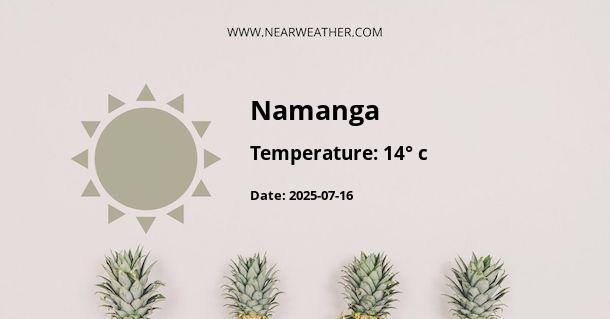Introduction
Namanga is a picturesque town located in Tanzania, East Africa. It's well-known for its unique weather patterns that contribute to the region's rich biodiversity. This content will dive deep into the climate and weather patterns of Namanga, providing essential information for visitors, researchers, and locals alike.
Geographical Location
Namanga sits at the border between Tanzania and Kenya, with the latitude of -2.55 and longitude of 36.7833. It's located in a region that experiences a tropical savanna climate, which is characterized by warm temperatures and distinct wet and dry seasons.
Climate Classification
Namanga's climate is classified as "Aw" under the Köppen-Geiger climate classification system. This signifies a tropical savanna climate with a pronounced dry season during the winter.
Annual Weather Overview
In Namanga, the temperature remains fairly consistent throughout the year, with monthly average temperatures ranging from 18°C to 28°C. The region experiences two rainy seasons and two dry seasons.
Temperature
The warmest month of the year is March, with an average temperature of 28°C. The coolest month is July, with an average temperature of 18°C.
Precipitation
The wettest month in Namanga is April, with an average rainfall of 220mm. The driest month is July, with little to no rainfall.
Seasonal Weather Patterns
The weather patterns in Namanga can be broadly divided into four seasons: two wet seasons and two dry seasons. The "long rains" occur from March to May, while the "short rains" occur from November to December. The dry seasons fall between these rainy periods.
Long Rains (March to May)
The period from March to May marks the "long rains" season in Namanga. During this time, the region experiences the highest rainfall, contributing to lush green landscapes and an abundance of wildlife.
Short Rains (November to December)
The "short rains" period from November to December witnesses less rainfall compared to the "long rains" period. However, it still contributes significantly to the area's biodiversity and agricultural productivity.
Dry Seasons (June to October, January to February)
The dry seasons in Namanga fall between June and October and January and February. These periods are characterized by low humidity, clear skies, and minimal rainfall, offering the best visibility for wildlife viewings and outdoor activities.
Conclusion
In conclusion, Namanga's tropical savanna climate shapes its unique weather patterns, contributing to its rich biodiversity and agricultural productivity. The region's warm temperatures and distinct wet and dry seasons offer a unique environment for both local residents and visitors. Awareness of these weather patterns can contribute to more effective planning for tourism, agriculture, and conservation efforts.
References
- Climate-Data.org. (n.d.). Climate: Namanga. Retrieved from https://en.climate-data.org/
- Weather Atlas. (n.d.). Namanga, Tanzania - Detailed climate information and monthly weather forecast. Retrieved from https://www.weather-atlas.com/
A - Namanga's Latitude is -2.550000 & Longitude is 36.766670.
A - Weather in Namanga is 20° today.
A - Climate Conditions in Namanga shows light rain today.
A - Humidity in Namanga is 89% today.
A - Wind speed in Namanga is 11.45 km/h, flowing at 49° wind direction. today.
